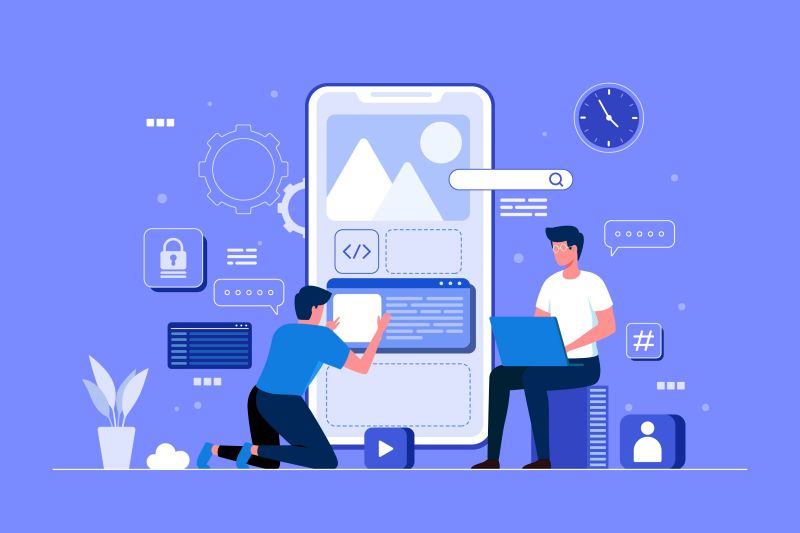In today’s fast-paced digital world, mobile apps have become essential tools for businesses to engage with customers, streamline operations, and boost revenue. Whether you’re a startup or an established brand, understanding the mobile app development process can pave the way for creating user-friendly and innovative apps that meet your business goals. But what does it take to develop a high-performing mobile app? This article will break down the journey step by step.
1. Understanding the Importance of a Well-Defined Process
The mobile app development process isn’t just about coding; it’s a structured approach to creating apps that align with user needs and business objectives. This process ensures a seamless experience, from conceptualization to launch, and reduces risks like delays or budget overruns. By following a methodical approach, you not only save time but also create an app that delivers value to its users.
2. Step-by-Step Guide to the Mobile App Development Process
Step 1: Define Your Goals and Target Audience
Before jumping into development, start by defining your app’s purpose.
- Questions to ask:
- What problem does the app solve?
- Who is your target audience?
- What platforms will the app support—iOS, Android, or both?
Understanding your audience’s behavior and preferences helps you design features that resonate with them.
Step 2: Conduct Market Research
Market research is crucial to identify competitors and industry trends.
- Tips:
- Analyze existing apps in your niche.
- Look for gaps or features users demand but competitors lack.
- Gather feedback from potential users through surveys or focus groups.
This data will inform your app’s features and unique selling points.
Step 3: Design the App’s Wireframe and User Interface (UI)
Creating a wireframe—a visual blueprint—helps you map out the app’s structure and flow.
- Focus on:
- Intuitive navigation.
- Clean and user-friendly UI.
- Accessibility features to cater to diverse users.
The design phase is critical to making a lasting first impression and encouraging user retention.
Step 4: Choose the Right Development Approach
When it comes to development, there are three main approaches:
- Native apps: Developed specifically for one platform, offering high performance.
- Cross-platform apps: A single codebase for multiple platforms, reducing costs.
- Web apps: Accessible through web browsers, suitable for simpler functionalities.
Selecting the right approach depends on your budget, timeline, and target audience.
Step 5: Build the App
The actual development phase involves coding the app based on your design and requirements. Developers work on front-end (user interface) and back-end (server-side functionality) aspects. Collaboration between designers and developers ensures smooth integration of features.
Step 6: Test the App Thoroughly
Testing is a non-negotiable part of the mobile app development process. It ensures the app functions flawlessly and provides a bug-free experience.
- Types of testing:
- Functional testing.
- Performance testing.
- Security testing.
- Usability testing.
Use both automated tools and real-user feedback to identify and fix issues.
Step 7: Launch the App
Once testing is complete, it’s time to launch your app on the desired platform(s). App stores like Google Play and Apple App Store have specific submission guidelines, so ensure your app complies with their requirements.
Step 8: Post-Launch Maintenance and Updates
The process doesn’t end with the launch. Regularly update your app to fix bugs, introduce new features, and adapt to user feedback. Continuous maintenance keeps your app relevant and engaging.
3. Best Practices for a Successful Mobile App Development Process
- Emphasize Scalability: Design the app to handle growing user bases without performance issues.
- Prioritize Security: Implement robust security measures to protect user data.
- Focus on User Feedback: Engage users through surveys or reviews to understand their evolving needs.
- Stay Agile: Use agile methodologies to adapt quickly to changes and updates.
4. Common Challenges and How to Overcome Them
Despite its benefits, the mobile app development process can present challenges, such as:
- Budget constraints: Start with an MVP (Minimum Viable Product) to test the market before scaling.
- Time management: Use project management tools like Jira or Trello to streamline workflows.
- Technical hurdles: Partner with experienced developers who can troubleshoot complex issues.
Conclusion
Mastering the mobile app development process involves more than just technical expertise—it requires strategic planning, market understanding, and a focus on user experience. By following this structured approach, businesses can create impactful apps that not only attract users but also drive long-term success. Whether you’re building your first app or refining an existing one, a well-executed development process is key to standing out in today’s competitive market.
For more interesting blogs click here.
